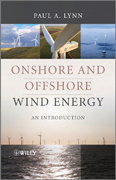
A highly accessible and authoritative account of wind energys scientific background, current technology, and international status, with an emphasis on large turbines and wind farms, both onshore and offshore Topics covered include: abrief history of wind energy the nature of the wind turbine aerodynamics, mechanics, and electrics wind farms offshore opportunities and challenges grid integration of wind energy economic and environmental aspects Whilst intellectually rigorous, this is not an academic treatise. Key equations are fully discussed, providing essential theoretical background. The text is supported by copious illustrations and about 50 inspiring full-colour photographs from around the world. This book is aimed at a wide readership including professionals, policy makers and employees in the energy sector in need of a basic appreciation of the underlying principles of wind energy or a quick update. Its style and level will also appeal to second and third year undergraduate and postgraduate students of renewable and wind energy, energy systems and electrical/electronic engineering. It also gives a concise account of the technology for the largeand growing number of people who are interested in onshore and offshore wind farms and the contribution they are making to carbon-free electricity generation in the 21st century. INDICE: Preface. Acknowledgements. 1. Introduction. 1.1 Wind Energy and Planet Earth. 1.2 Winds of the World. 1.3 From Windmills to Wind Turbines. 1.4 Power, Energy, and Performance. 1.5 Coming up to Date. References. 2. Capturingthe Wind. 2.1 Wind Speed and Power. 2.2 Wild Wind. 2.2.1 Introductory. 2.2.2 Wind Statistics. 2.2.3 Mapping and Forecasting. 2.3 Predicting Turbine Output.References. 3. Wind Turbines. 3.1 Turbine Types and Sizes. 3.2 Aerodynamics. 3.2.1 Rotor Efficiency and the Betz Limit. 3.2.2 Lift and Drag. 3.2.3 Rotor Speed. 3.2.4 Rotor Blades. 3.2.4.1 Choosing Airfoils. 3.2.4.2 Stall and Pitch Control. 3.3 Mechanics. 3.3.1 Gearboxes. 3.3.2 Towers. 3.3.3 Vibration and Fatigue. 3.4 Electrics. 3.4.1 AC Electricity. 3.4.2 Generators. 3.4.2.1 Introductory. 3.4.2.2 Synchronous Generators. 3.4.2.3 Asynchronous Generators. 3.4.2.3.1 Squirrel-cage and Wound-rotor Induction Machines. 3.4.2.3.2 Doubly-fed Induction Generators. 3.5 Turbine Control. 3.6 Onshore Wind Farms. 3.6.1 Introductory. 3.6.2 Siting and Spacing. 3.6.3 Monitoring and Control. References. 4. Moving Offshore. 4.1 Introductory. 4.2 Wind and Waves. 4.3 Turbines and Foundations. 4.4 Offshore Wind Farms. 4.4.1 Case Study: Horns Rev 2. 4.4.2 Case Study: London Array. 4.5 Bringing the Power Ashore. References. 5. Grid Integration. 5.1 Setting the Scene. 5.2 Connecting to the Grid. 5.2.1 Grid Strength and FaultLevels. 5.2.2 Electrical Quality. 5.3 Large-scale Wind Power. 5.3.1 Introductory. 5.3.2 Intermittency and Variability. 5.3.3 Capacity Credit and Backup Generation. References. 6. Economics and the Environment. 6.1 Wind Energy Economics. 6.1.1 Capital and Installation Costs. 6.1.2 Operation, Maintenance and Cash Flow. 6.2 Environmental Aspects. 6.2.1 Introductory. 6.2.2 Landscape and Amenity. 6.2.3 Birds, Bats, and Farming. 6.2.4 Seabirds, Fish, and Marine Conservation. References.
- ISBN: 978-0-470-97608-1
- Editorial: Wiley
- Encuadernacion: Cartoné
- Páginas: 248
- Fecha Publicación: 01/01/2012
- Nº Volúmenes: 1
- Idioma: Inglés
